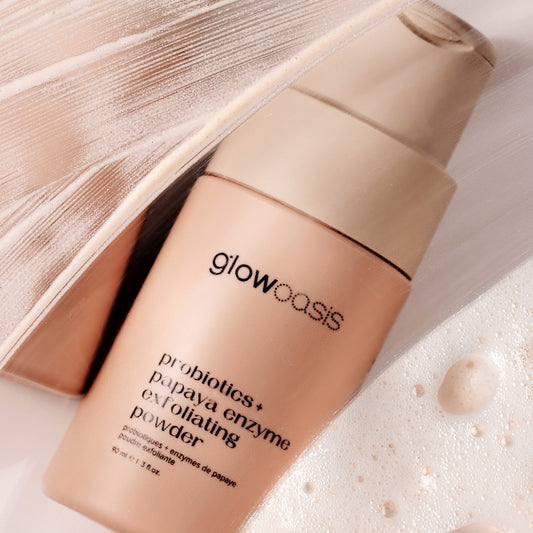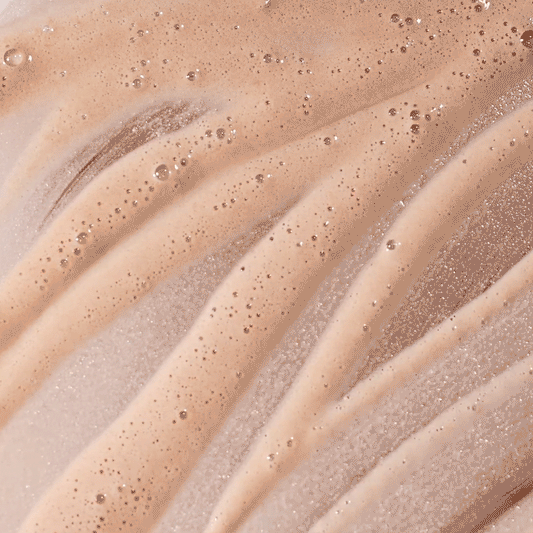Exfoliation is one of the most important steps of any skincare routine. It helps purify your pores, smooth your skin’s texture and reveal an overall brighter, more refined complexion. But, did you know there’s more than one method of exfoliation? That’s right, there’s enzymatic, physical, and chemical exfoliation. Each is unique from one another. To learn more about these types of exfoliation, and find the one that’s right for you, keep reading below.
What is exfoliation?
Exfoliation is the process of removing dead skin cells from the skin’s surface. This helps to get rid of dry, dull skin while improving both tone and texture. Exfoliation also unclogs your pores, promotes circulation, and allows your skin to better absorb the products you apply to it. With exfoliation included in your regimen, your skin will truly look and feel like it’s glowing!
Enzymatic
One of the best ways to exfoliate is with an enzyme exfoliant. As the name suggests, this type of exfoliation often comes from fruit or grain enzymes — like papaya, pineapple, or rice. These enzymes work to break down and dissolve the keratin in your skin’s upper layers, which hold the dead skin cells together, and open your pores for easier extraction. Since the enzymes are only digesting the cells, you don’t have to worry about over-exfoliating. It is the gentlest form of exfoliation and is great for all skin types, including sensitive skin.
At glowoasis, we offer an enzyme exfoliant you’re sure to love. Our probiotics + papaya enzyme exfoliating powder is infused with natural fruit enzymes from papaya, as well as jeju volcanic ash, niacinamide, vegan probiotics, and prickly pear extract. These ingredients combine to exfoliate dead skin cells on and below the skin’s surface without ever having to scrub. The probiotics + papaya enzyme exfoliating powder helps reduce inflammation, balance pH levels, detoxify pores and retain moisture. Just mix the enzyme powder with water, and it will transform into a luxurious lather that leaves your skin soft and luminous.

Chemical
Another method of exfoliation is chemical exfoliation. Chemical exfoliants work beneath the skin’s surface to dissolve the protein bonds between dead skin cells. This helps easily shed dead, flaky skin, so you can unveil a fresh complexion. Chemical exfoliants are known to improve the overall appearance of scars, and high pigmentation. However, you must be using the right dosage, because too much of a chemical exfoliant may burn the skin. Acids are the most common chemical exfoliants, especially alpha-hydroxy acids (AHAs) and beta-hydroxy acids (BHAs).
AHAs are water-soluble acids, like lactic or glycolic acids, that are typically derived from natural substances. They’re able to split up the bonds between dead skin cells, which allow you to exfoliate and help repair dry, aging, and sun-damaged skin. AHAs are also shown to renew the skin and reduce the look of fine lines.
Physical
Of course, there’s physical exfoliation too. This is a process where grains, microbeads, or scrub-like textures are used to physically buff away dead skin cells found on the skin’s surface. Physical exfoliants leave your skin feeling instantly smooth. Some of the most popular types include sugar scrubs, coffee powder, exfoliating brushes, and microdermabrasion.
It’s important to avoid harsh, abrasive physical exfoliants because those may create micro-tears in the skin. Micro-tears can lead to skin inflammation and free radical damage. Physical exfoliation might be irritating for those with sensitive or highly reactive skin types, so it’s best to use physical exfoliants on the body rather than your face.
No skincare routine is complete without exfoliation!
And, with three different exfoliation methods to choose from, we know you’ll find the one that’s best for you and your skin. For more information on exfoliation, please check out our “exfoliating 101: a guide for beginners” blog post.

